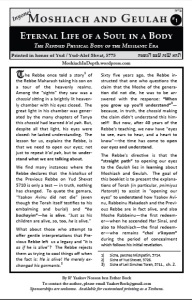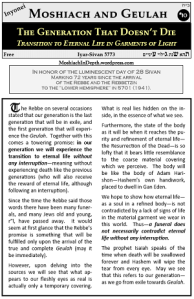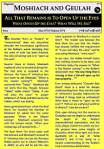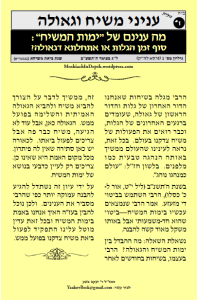In the sicha of parshas Korach, Gimmel Tammuz, 5751, the Rebbe explains at length the great miracle which occurred on Gimmel Tammuz in the days of Yehoshua bin Nun: the sun and the moon (and the entire cosmic system) stood still. “Shemesh b’Givon dom“.
This miracle doesn’t seem to have such an obvious connection to the miraculous Geuloh of the Rebbe Rayatz in 5627 (the subject of the Rebbe’s farbrengen), but mashpiim find an obvious connection to the events of Gimmel Tammuz 5754: that just as it was by Yehoshua bin Nun, that he commanded the sun and the moon (and the entire cosmos) to stand still, causing time to “freeze” in order to enable the Yidden to win the war they were waging on their own effort, so too we are in a “frozen moment” where the Rebbe wants us to finish the war to end golus with our own effort. But there is an even greater insight, as we hope to explain with Hashem’s help.
When Gimmel Tammuz comes around, half the farbrengens are on the theme of celebrating “as’chalta d’Geuloh” (the beginning of the Geuloh), and the other half are on the theme of hillula. Come and hear an amazing reconciliation of this widespread confusion:
When Eliyahu HaNovi was preparing to ascend heavenward, he asked his disciple Elisha what he could do for him “before I will be taken from you.” Elisha responds with a puzzling request: a double-portion of Eliyahu’s prophetic spirit should rest upon him. Eliyahu replies that this is a difficult request, meaning it is impossible to give more than one has (Rashi)! Nonetheless, Eliyahu adds that if he (Elisha) will see him being taken from him, then he can fulfill his request.
There are various answers given to the question: how could Eliyahu HaNovi give his disciple more than what he possesses. The answer we will present here is explained in depth in Likutey Mohoron (Breslov), and will open our eyes to something amazing.
In Likutei Mohoron (ch. 66) it explains, based on the Zohar, that every Tzaddik possesses two dimensions of ruach — his supernal ruach, and his lower ruach. He lives his life in this world with his lower ruach, but when the time of his histalkus arrives, the supernal ruach descends to this world and unites with the lower ruach (compare with Igeres Hakodesh, siman 27). This means that the Tzaddik, in his final moments in this world, has a lofty revelation that far exceeds what he experienced in his lifetime. Continues Likutey Mohoron: once the two aspects of ruach unite, the supernal ruach has to leave this world (because its nature is that it cannot tolerate to be here), and it ascends together with the lower ruach, which has united with it, and this is the Tzaddik’s histalkus. Thus we find that by Rashbi, for example, he revealed the loftiest things in his final moments.
It comes out that every Tzaddik has three distinct stages:
- his life in this world when only his lower ruach is accessible;
- his final moments when his supernal ruach is revealed in this world;
- his departure from this world, together with both dimensions of his ruach.
In the story of Eliyahu and Elisha, it was these “final moments” which provided the opportunity for Elisha’s request to be fulfilled: Eliyahu was still alive in this world, but with the revelation of his supernal ruach. Prior to this moment, he could not give a double portion because he himself didn’t have it; after this moment, he was already gone from the world and couldn’t give it over; but in exactly these final moments he had both aspects, and thus he could in fact fulfill Elisha’s request for a double portion.
These final moments paradoxically combine the elements of physical life together with the lofty qualities the Tzaddik attains when he is nistalek. At that moment he is both “chai v’kayam” and at the same time “more than he was in his lifetime” (יתיר מבחיוהי, in the loshon of Igeres Hakodesh).
Now imagine that at this very moment the sun and the moon stand still. Time freezes and the Tzaddik’s ascent is also “frozen” — he remains “chai v’kayam”, alive as a soul in a body in this world, together with supernal revelations that are reserved for a histalkus. Instead of a fleeting moment of opportunity for his disciples and mekusharim to receive a double portion, this moment of opportunity doesn’t end…
We could say that this is a deeper dimension of the Rebbe’s lengthy explanation of the sun and moon standing still: that the time will come (3 years to the day after the Rebbe spoke the sicha) when the Rebbe will make use of this gimmel Tammuz miracle of “Shemesh b’Givon dom” to create an unprecedented situation: the Rebbe will be holding by both realities! He will continue to be chai v’kayam without histalkus (as the Rebbe tells us in the sicha of Bo 5752 that our generation will not experience histalkus), yet at the same time “more than he was in his lifetime” (יתיר מבחיוהי), which is a lofty state which is achieved at the time of — histalkus?!
This explains (and even validates) the divergent perspectives: yes, the Rebbe remains chai v’kayam b’guf gashmi, and yes, he also possesses the qualities of “more than in his lifetime”. Practically speaking, it gives each and every one of us the opportunity to receive from the Rebbe even greater koichos than were available all the years, because the Rebbe himself is holding by greater koichos. And it also gives us the keilim to understand how half of Lubavitch looks at Gimmel Tammuz differently from the other half!* These feel the Rebbe lives, those feel “more than in his lifetime”, and both think that you can’t have the two together. But, in fact, we can, and apparently we do!
May we utilize these great koichos to bring the Geuloh b’poel mamash and truly open our eyes to the reality of the Redemption.
*) This recalls the explanation, attributed to the Helige R’ Yisroel of Ruzhin, of the machloikes between the Alter Rebbe (who advocated spreading the wellsprings of Chassidus) and R’ Boruch of Mezibuz (who was opposed to spreading Chassidus broadly). He said that when Moshiach told the Baal Shem Tov that he would come when “your wellsprings will spread out”, the Baal Shem Tov’s eyes welled up with tears. R’ Baruch, a grandson of the Baal Shem Tov, felt the pain of his grandfather’s tears that his wellsprings would have to descend to “chutza”, and therefore opposed something which caused his grandfather pain. The Alter Rebbe, though, was a spiritual grandson of the Baal Shem Tov, and he felt the pain of the Baal Shem Tov that derived from the long time it would take to spread out the wellsprings before Moshiach would come, therefore he worked to speed it up. We could say that the Rebbe has Chassidim that are more attuned to the reality of “chai v’kayam“, and Chassidim that are more attuned to the reality of “more than in his lifetime”, and all that is lacking for achdus is to expand the keilim.
The text of Likutey Mohoran in Hebrew and English
here.





